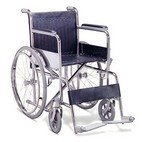Dealing With Bodily Function Unpleasantries
 It had never occurred to me that when one has a spinal cord injury, muscles controlling bodily functions may be affected. Soon after being hospitalized I had an indwelling catheter inserted which, although changed periodically, basically remained with me for several months. Late in my stay at the rehab hospital a nurse enthusiastically informed me that I’d be going to “in & out” catheterization. Like somehow I’d be delighted in having to stick a plastic straw up my “wazoo” to allow urine to be drained out every few hours before it decided to release on it’s own. The prospect was not appealing to me at all! In a rush to get to an appointment one day, I was outfitted with an external condom catheter and leg bag. For whatever reason, I ended up using the external catheter on an ongoing basis, even after being discharged.
It had never occurred to me that when one has a spinal cord injury, muscles controlling bodily functions may be affected. Soon after being hospitalized I had an indwelling catheter inserted which, although changed periodically, basically remained with me for several months. Late in my stay at the rehab hospital a nurse enthusiastically informed me that I’d be going to “in & out” catheterization. Like somehow I’d be delighted in having to stick a plastic straw up my “wazoo” to allow urine to be drained out every few hours before it decided to release on it’s own. The prospect was not appealing to me at all! In a rush to get to an appointment one day, I was outfitted with an external condom catheter and leg bag. For whatever reason, I ended up using the external catheter on an ongoing basis, even after being discharged.Prior to this injury I could hold urine like a camel holds water. Post injury, I found that I could hold for a reasonable length of time but when I felt that I HAD to go, I HAD to go!! The external catheter was preferable to manual insertions, which I felt could induce urinary tract infections (UTI) faster than the external catheter. In order to use the external condom catheter one needed to get a decent seal between skin and condom catheter. This required the use of a ‘skin prep’ which came as a small towelette in a pouch, much like the towelette wipes offered in restaurants after eating greasy finger foods. Trouble was that the fluid burned like hell each time it was applied. The seal did not always hold and a loose condom or detached hose certainly contributed to some embarrassing situations.
So much so that about a year post-injury, I became fed up and decided to go naturally whenever the need arose. At this point I could not yet stand effectively but around the house I would wear shorts, a pant leg of which could be hiked up to use a urinal bottle as the needed. Outside I might still have used the catheter/leg bag. Now, I can stand without difficulty allowing me to pull full length pants up and down so have stopped using the leg bag altogether, even when out in public. I still prefer to go in a container and then discard the urine rather than try to aim for the porcelain for hygienic reasons.
As for No.2, the bowel treatment concept was to have ‘treatment’ days to deal with evacuating the bowels at scheduled intervals. Stool softeners (Dulcolax) and a laxative (Senokot) were given the night before and the following morning you were given a suppository before being placed on a commode and being wheeled onto a toilet. There the suppository would trigger your bowels to evacuate and hopefully you were set for another couple of days without an accident. Disposable diapers were required for leakage.
You can imagine how unpalatable that treatment was.
Soon after discharge I decided to try to go naturally and found that I could. After discontinuing the artificial regime, my system returned to normal and now I just go when and as necessary.
I find I can clean myself up while on the commode and wheel myself in for a shower to completely clean up after each and every movement.
So, in summary, I “take a leak” naturally whenever I feel the urge, however I still cannot hold it too long and have to make for a washroom soon after the first sensations arrive. I do use a container rather than drive up to a toilet and try to aim directly as positioning may not be optimal and I don’t wish to irrigate my pants nor the public facilities. I “take a dump” naturally, without the aid of stimulants etc. whenever the need arises. I suspect I probably go less often than when I was ambulatory because of not being upright. Continuous walking, bending and moving probably helps the bowels move contents along.
On discharge from the rehab hospital, no mention was made of changes that I might expect or alternatives I might try to make these unpleasantries a bit easier. My methods of coping were developed on my own.







.jpg)

No comments:
Post a Comment